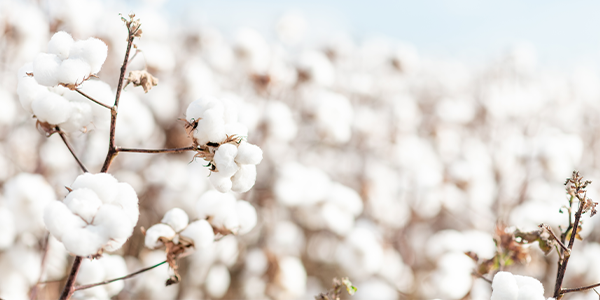A Win-Win for Growers and Apparel Brands

Soil health is crucial for sustainable agriculture and cotton production is no exception. Cotton Incorporated is dedicated to promoting soil health practices among cotton growers to improve cotton fiber quality, yield, and sustainability.
In this Q&A session, we spoke with Dr. Gaylon Morgan, the director of Agricultural Research at Cotton Incorporated with 22 years of experience in applied cotton research, to learn more about the benefits of soil health practices for cotton production, how they can be implemented and how they impact brands and retailers.
Q: Gaylon, soil health is a buzzword in the industry today. What does the term “soil health” mean?
A: According to the Natural Resources Conservation Service (NRCS), soil health refers to “the continued capacity of soil to function as a vital living ecosystem that sustains plants, animals, and humans.”1 Healthy soils have high levels of microbial activity, organic matter, and good soil structure. However, because soil properties vary based on climate, geology, topography, and land use and management history, “healthy soil” can look different in different places. The key is working toward continual improvement in soil health.
Q: What farming practices can cotton growers use to promote healthy, regenerative soils that also benefit cotton fiber quality or yield?
A: Some farmers across the United States have been implementing soil health practices for decades and have reaped the benefits of reduced erosion, improved early-season crop development, and weed suppression. The research and outreach on soil health practices over the past 10-15 years have shown many other benefits from soil health practices, including increased water infiltration, increased nutrient cycling, and increased water holding capacity. As a result, there has been increased adoption of soil health practices which continues to occur. Specifically, farmers can implement various forms of reduced tillage systems, no-till or strip-tillage, that reduce soil disturbance. Farmers can leave crop residues undisturbed on the soil surface between crops and they can add cover crops into their cropping system.2
Q: Gaylon, you mentioned cover crops, what are cover crops and how do they contribute to soil health?
A: Cover crops are typically added to a crop rotation in between two commodity or forage crops to provide living, seasonal soil cover with a variety of on-farm benefits, such as increased soil moisture capacity, improved nutrient cycling, and weed suppression. Cover crops can also provide public benefits by reducing sediment loss, nutrient runoff, and leaching; reducing flooding; and storing carbon in the soil.3


Q: Can you explain how soil health can impact the carbon footprint of cotton production?
A: All the soil health practices mentioned are focused on keeping living roots in the soil as much of the year as possible, leaving crop residues on the soil surface, and minimizing the disturbance to the soil with the goal of increasing soil organic matter to improve the soil. Each of these practices also increases soil organic matter, which is carbon sequestration. In short, good soil practices will increase carbon sequestration in the soil.
Q: Gaylon, we’ve talked about the importance of soil health in cotton production, but for brands and retailers, what are some common misconceptions about cotton and soil health that you’d like to clear up?
A: That’s a great question. Change is difficult for everyone, especially when a person and their family’s livelihood depend on it. For many growers, some soil health practices are counter to the way crops have been grown on their farms for decades. Also, some soil practices add a new level of complexity to their farming operations and require new investments in equipment. So, widespread adoption of soil health practices will take time as the science evolves and growers make their journey to healthier soils. Cotton, like other dicot crops, does not leave much crop residue on the soil surface, which leads some to believe that cotton is less desirable for healthy soil. However, cotton in rotation with grain crops and cover crops makes a great rotational system for improving soil health, and increasing nutrient cycling, and is a great Integrated Pest Management (IPM) approach.
Q: Is there any other information you’d like to share about soil health practices in cotton production?
A: Yes, Cotton Incorporated is funding research to advance our understanding of soil health practices, including decreasing fertilizer use, improving water use efficiency, and increasing biodiversity. Additionally, funding is directed toward outreach efforts to educate growers on the benefits of soil health practices and the best methods for integrating them onto their farms.4
Overall, promoting soil health practices among cotton growers is not only important for the environment, but also for the apparel industry as a whole. Apparel brands and retailers have been under increasing pressure in recent years to adopt sustainable practices and reduce their environmental impact. This includes the production of the raw materials used to make their products, such as cotton. By promoting and supporting soil health practices among cotton growers, apparel brands and retailers can demonstrate their commitment to sustainability and meet the increasing demands of consumers for more environmentally responsible products.
To learn firsthand how a North Carolina farmer benefits from soil health practices, check out Andrew Burleson’s interview showcasing how no-till farming can protect and improve soil health leading to more resilient, higher-quality cotton.

Dr. Gaylon Morgan
Director of Agricultural Research
Cotton Incorporated
- National Resources Conservation Service, Soil Health: https://www.nrcs.usda.gov/conservation-basics/natural-resource-concerns/soils/soil-health
- Soil Health—Cotton Today: https://cottontoday.cottoninc.com/our-sustainability-story/land/soil-health
- USDA Economic Research Service—Grass Cover Crops, Such as Rye and Winter Wheat, Are the Most Common Cover Crops Used Before Planting Corn, Soybeans, and Cotton (July 06, 2021): https://www.ers.usda.gov/amber-waves/2021/july/grass-cover-crops-such-as-rye-and-winter-wheat-are-the-most-common-cover-crops-used-before-planting-corn-soybeans-and-cotton
- CottonWorks™—Land Use & Soil Health: https://cottonworks.com/en/topics/sustainability/cotton-sustainability/cotton-sustainability-basics/#soil